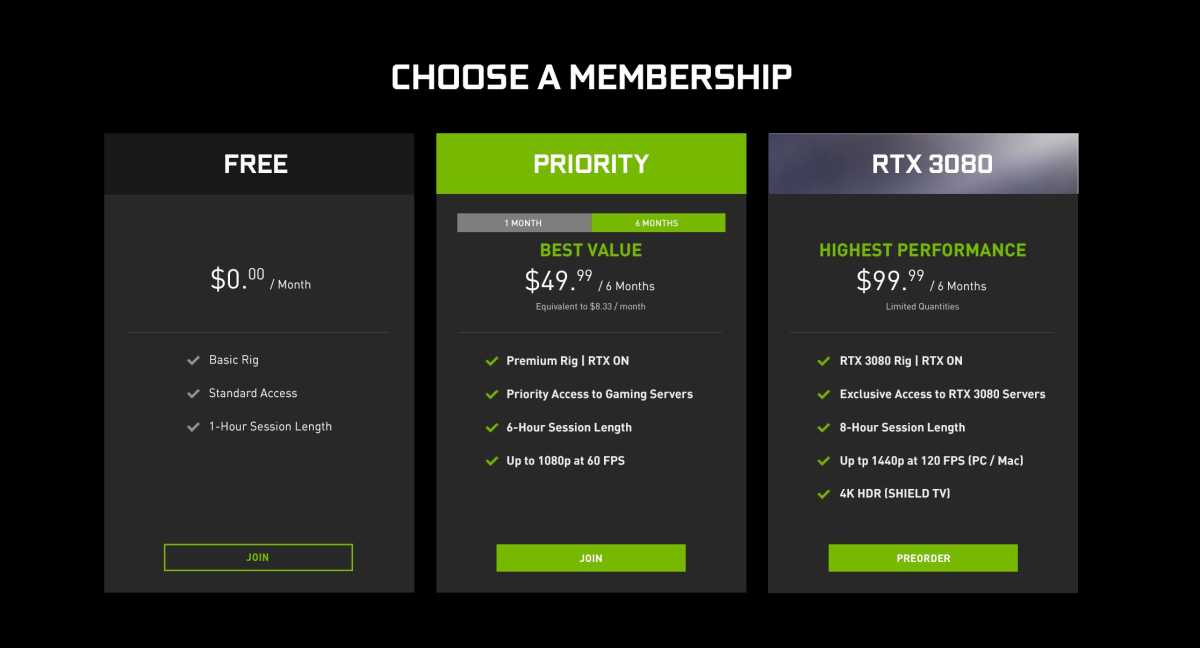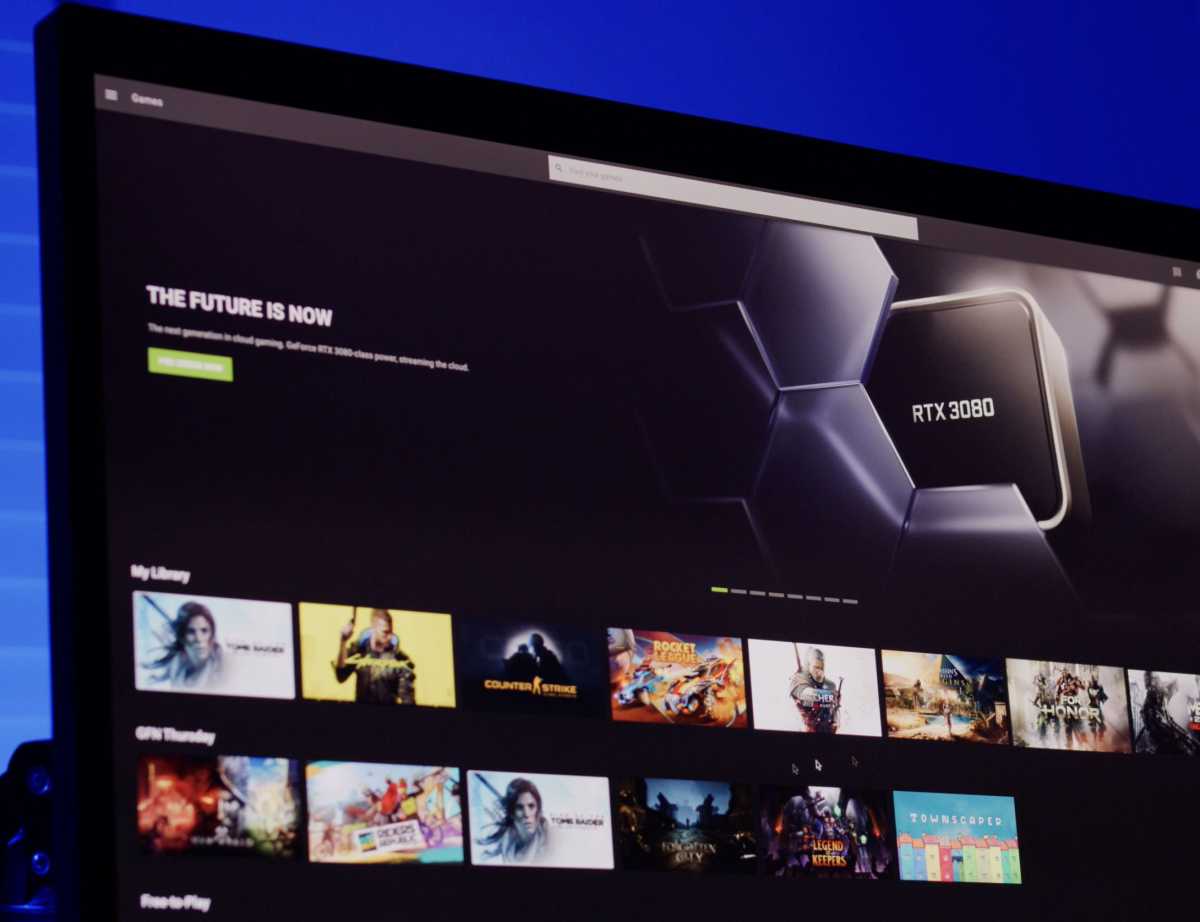
 Image: Nvidia
Image: Nvidia
Nvidia’s GeForce Now is a cloud streaming service that targets the current weak spot in the market: hardware availability and pricing. Essentially, you pay a subscription fee for the ability to use Nvidia’s “Superpod” computers to stream games from your library in lieu of having a physical GPU in your PC at home. The company recently announced an RTX 3080 tier, which claims lower latency and ray tracing–enabled performance. We will discuss how it works, potential drawbacks, and price. The technology is very exciting, but can it replace a real GPU during the great shortage? Let’s find out!
How does it work?
By utilizing “Superpod” computers with 1,000 GPUs in each (if you opt for the top RTX 3080 tier), Nvidia leverages cloud streaming to allow you to access your game libraries (such as Steam, Epic games, etc.) You can play on a variety of devices, too. Old Apple Macbook? Sure, that works. How about an old clunker PC with a 5-year-old GPU? That’s fine, too. Even your browser can now be a powerful PC! Essentially, this is “Hardware as a service,” in contrast to software as a service such as what we’re used to with Netflix, et al.

Nvidia
Nvidia
Nvidia
What are your options? Nvidia offers a free basic tier, which limits you to one-hour sessions and entry-level hardware. You can upgrade to the Priority tier, which will cost you $49.99 for six months. With this, you get extended sessions of six hours, and more powerful RTX 2080–level hardware. You’ll max out at around 1080p, 60fps. The new RTX 3080 tier will cost $99 for six months, but you’ll be upgraded to 1440p 120fps on most devices. With an Nvidia Shield, you’ll even be able to do 4K with HDR! Eight-hour sessions are allotted for the long-haul gamers here, as well.
The pros and cons of Geforce Now cloud gaming
Streaming RTX 3000–level GPU performance sure sounds a lot easier than waiting days in line at your local store to pick one up, doesn’t it? Let’s examine the pros and cons for the service:
Pro: Entry-level GPUs carry a massive price premium during this GPU shortage, so $49.99 for six months to rock 2080-level hardware is comparatively a good deal. The $99/six-months RTX 3080 tier will allow gamers to experience ray tracing and even 4K HDR, which is a relative bargain compared to real RTX 3080 pricing (nearly double to triple the MSRP currently).
Con: This is hardware as a service; you’re paying a subscription fee to use a virtual GPU. That makes resale value of traditional hardware out of the equation. You must weigh this against the cheaper upfront costs and added value.
Pro: GeForce Now works on a large spectrum of existing systems. You’ll be able to run it on Apple Macbooks, old PCs, and even mobile devices or browsers. That is excellent flexibility and saves you tremendous cost on acquiring other supporting hardware that traditionally accompanies a high-end GPU (such as high-performance CPUs, RAM, etc).
mentioned in this article
GeForce RTX 3080

 Read our reviewPrice When Reviewed:$699Best Prices Today:$800 at Newegg | $864.22 at Walmart | $911.84 at Amazon
Read our reviewPrice When Reviewed:$699Best Prices Today:$800 at Newegg | $864.22 at Walmart | $911.84 at Amazon
Con: The technology isn’t perfect. The biggest issue here will be with your internet connection and latency. For the top RTX 3080 tier, Nvidia recommends at least a 35Mbps connection for smooth performance. Issues with lag, disconnects, and low-resolution buffering are all facts of life on cloud streaming services if you have internet issues. While the RTX 3080 tier leverages a more powerful “rig,” and Nvidia utilizes lower-latency technology, you’ll get the best experience with fast internet.

Nvidia
Nvidia
Nvidia
Pro: You’ll be able to stream your game library, with over 1,000 games supported. If you’ve been building up your Steam collection over the years, GeForce Now will give you access. There are also over 70 free game titles available so you can jump right in!
Con: Not every game you own will be supported, and some game types are not well suited for cloud gaming. E-sport and competitive shooter games, which do best under the lowest latency possible, may not be ideal. They’ll be playable, but keep in mind that for best performance you’ll want a physical GPU for these types of titles. Single player and more casual open-world games should be fine, however.
Pro: If you have a solid internet connection, you’ll be able to play the latest AAA titles with high graphical fidelity, ray tracing, and generally good performance. You’ll also forgo having to deal with hardware issues and driver updates that accompany high-end GPUs. Most importantly, you’ll also stop worrying about the current GPU shortage and ridiculously pricing.
Con: If your internet goes out, then you’ll be out of luck for that gaming period. You also won’t have the ability to overclock or modify your hardware if you’re an enthusiast. This may be a sigh of relief for some who just want to get straight to gaming, however.
Is GeForce Now worth it?

Thiago Trevisan/IDG
Thiago Trevisan/IDG
Thiago Trevisan/IDG
During this historic GPU drought, Nvidia’s GeForce Now is certainly an emerging technology that can add great value for those who want to game on capable hardware. The technology can be impressive with the ability to stream ray-traced games at 1440p and 120fps. For many gamers, this service is worth a try. It may even be a great way to keep yourself gaming while waiting for the GPU market to come back to normal. Hardcore gamers may still prefer a physical GPU, however—that’s where the best performance will be, as well as endless tinkering ability. (Plus, you’ll own the hardware —an important point for some who won’t want a subscription service).
While the underpinning technology is impressive, keep in mind it’s not always perfect, with real-world issues on the end-user side. You’ll need good internet and low latency to have a great experience, especially with the RTX 3080 tier. While we don’t think the eight-hour session limits on the top tier will be an issue for most, these are the types of limitations that you must keep in mind with a service like this.
In an ideal world, high-performance GPUs would be available at their MSRP pricing, and most gamers would have access to modern improvements in technology. Considering the current market, GeForce Now is a reasonable alternative for those who want to experience next-level gaming at a more reasonable upfront cost. Some may even prefer to use a service like this in lieu of getting a GPU to stay on the bleeding edge.
Could PC hardware go extinct like the dodo bird, or Blockbuster Video? Unlikely, but with improving technology, streaming can certainly be an interesting option. If latency standards continue to improve, and Nvidia keeps offering value for the subscription fee, it may even attract more hardcore gamers, GPU shortages or not. We’d love to see something like Xbox Game Pass offered, where you’d get great AAA-level games that you can keep in your library. (In addition to the free titles offered already.) It’s great to have options—especially during our current GPU market. You can choose to game on physical hardware or get your head in the clouds!
Author: Thiago Trevisan
Recent stories by Thiago Trevisan:
GeForce RTX 4070 vs. RTX 3080 vs. Radeon RX 6800 XT: Which to buy?MSI Z790 Edge WiFi DDR4: A motherboard with a silver liningMSI MEG X670E Ace: Top Gun performance for your Ryzen CPU




